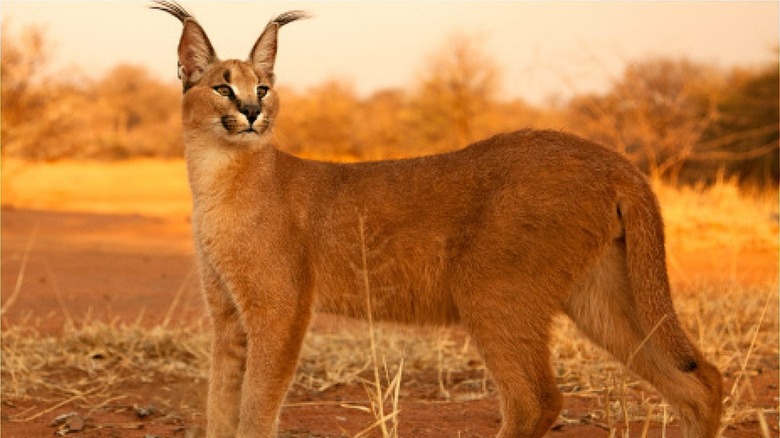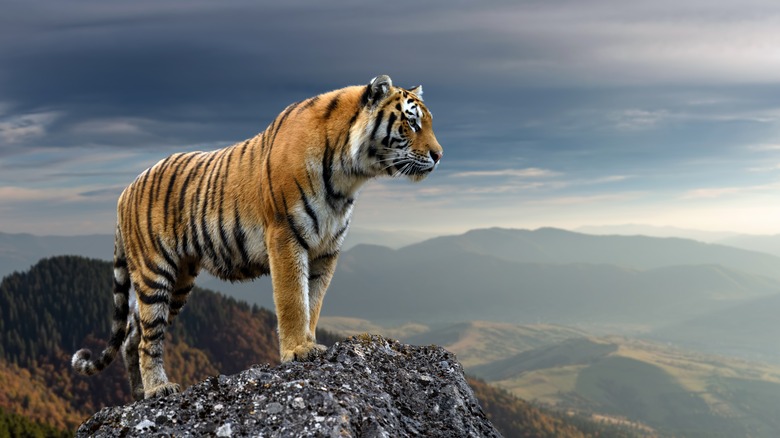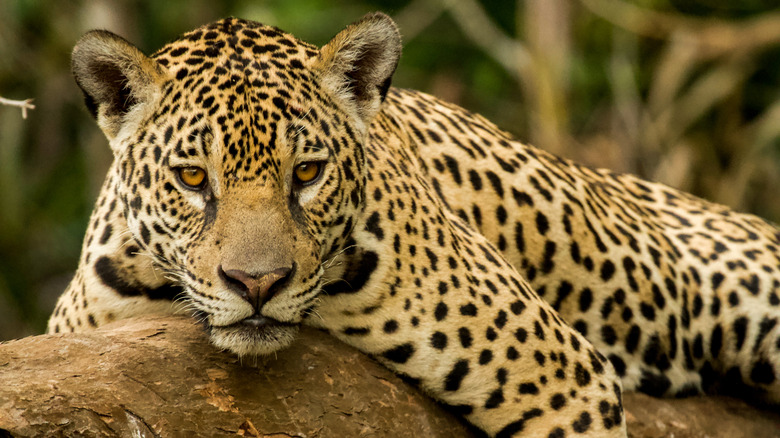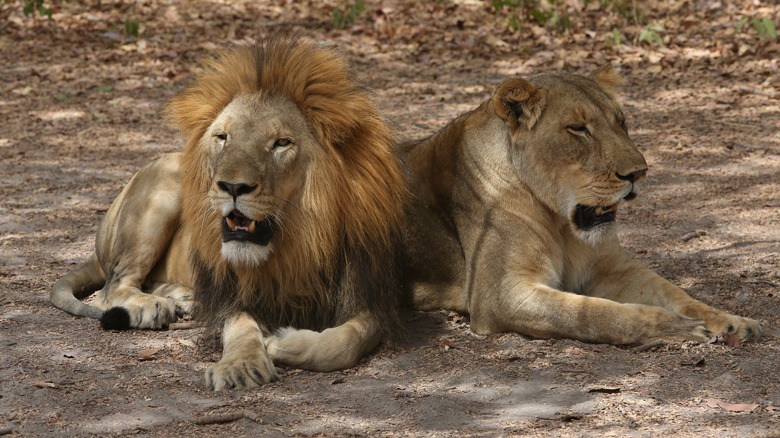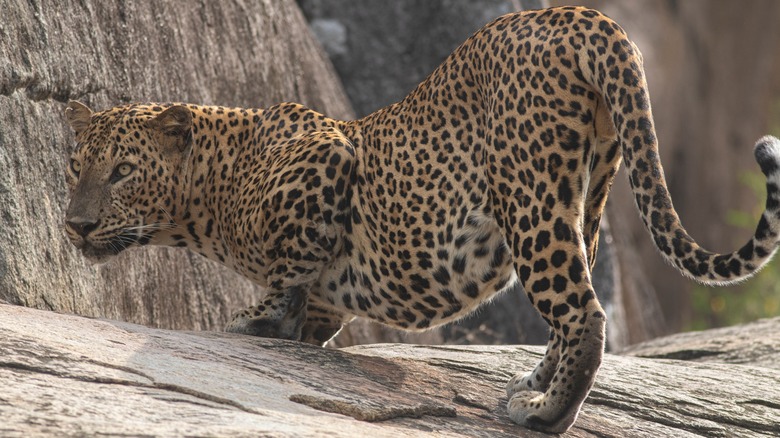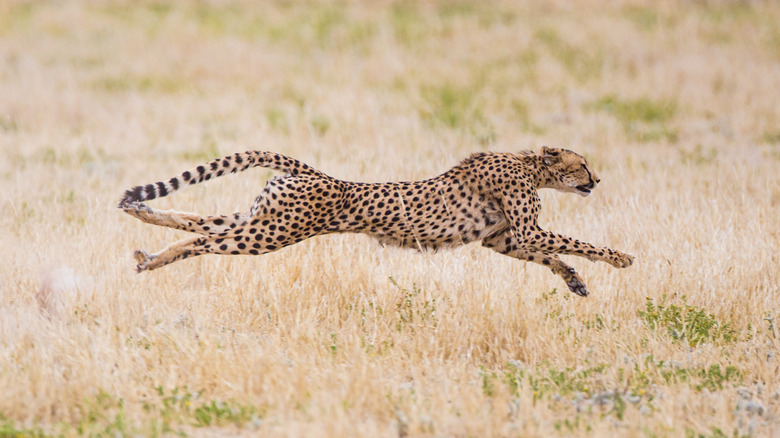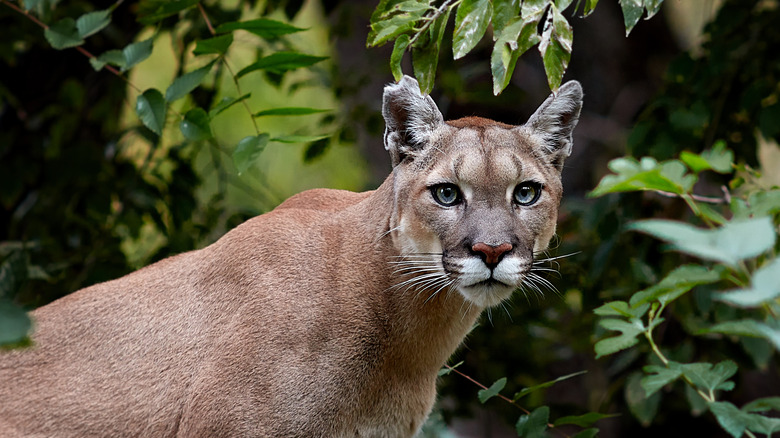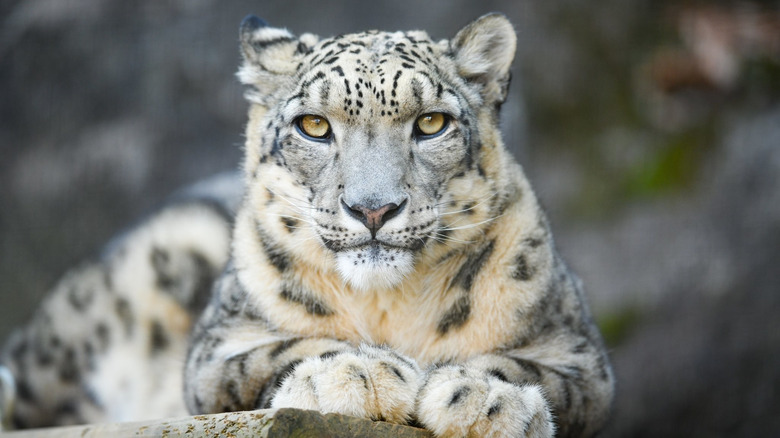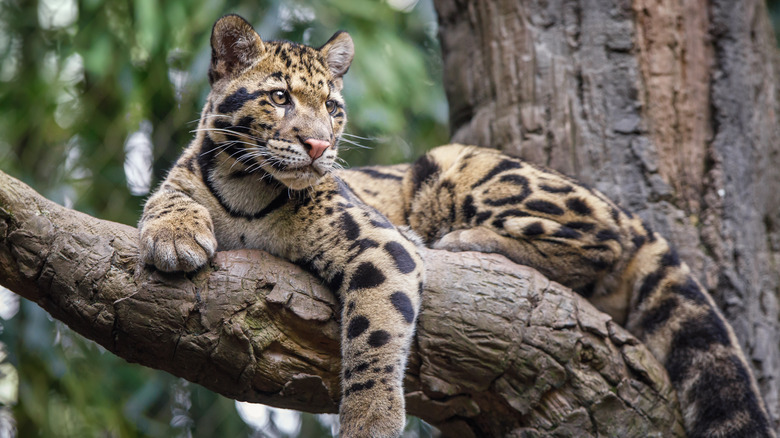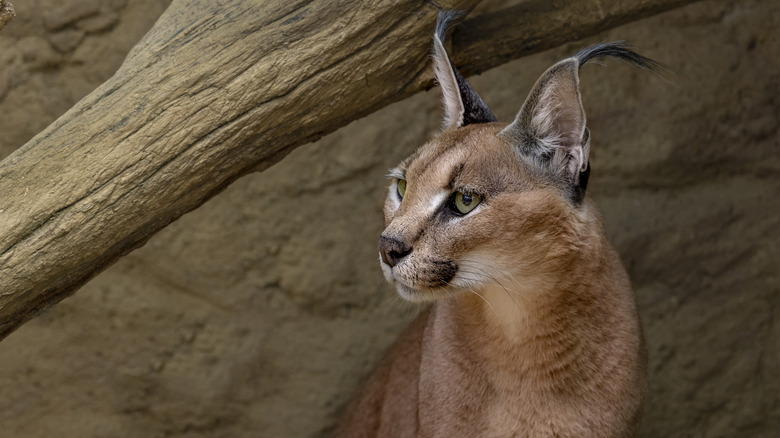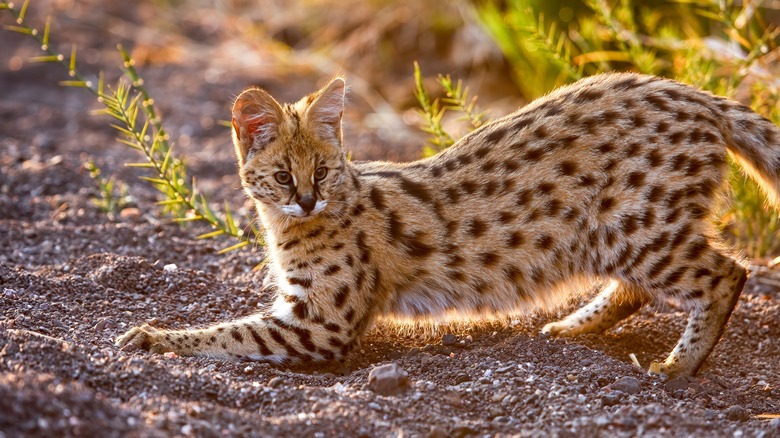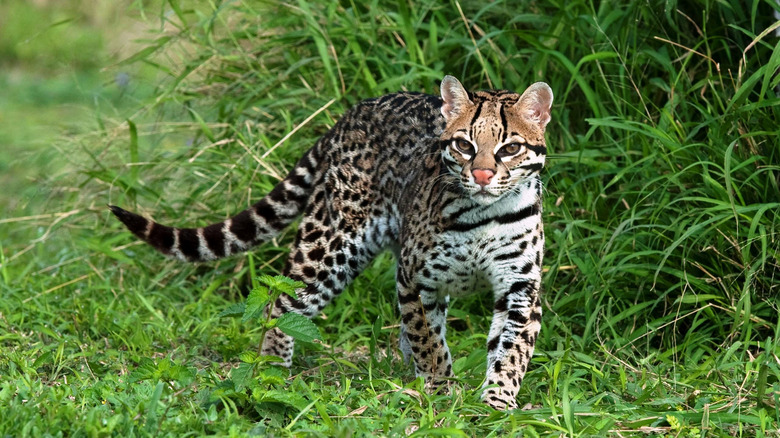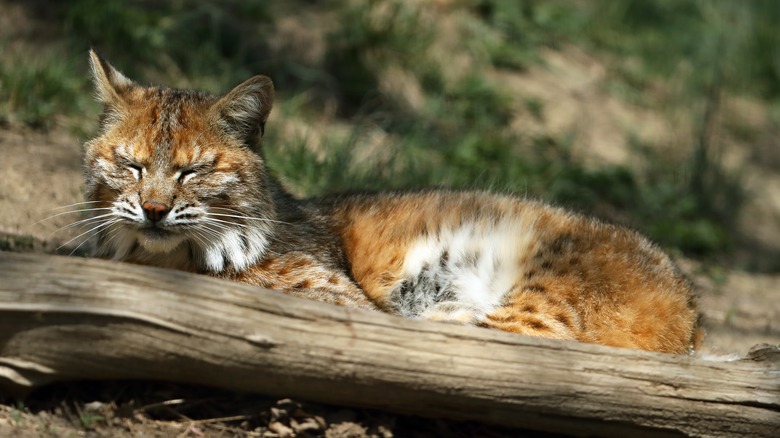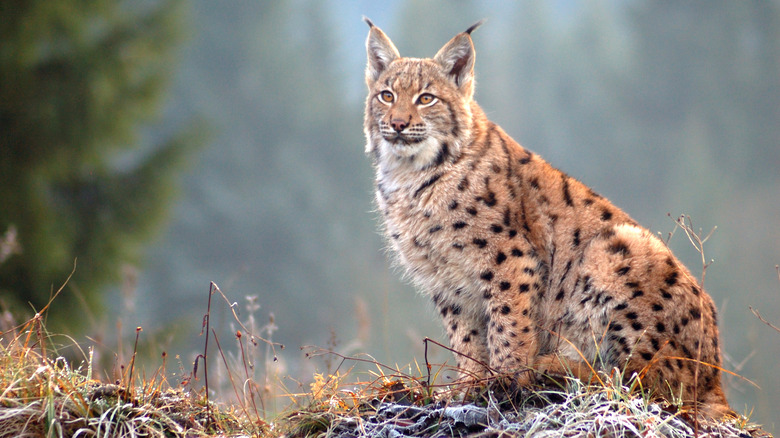The Differences Between These 13 Feline Species
One close look at any social media platform will reveal we currently live in a cats' world — our tiny house felines make up an estimated 15% of internet traffic, at least according to Purina (via CNN). However, larger felines don't get nearly as much attention. And for all those who aren't zoologists or animal behaviorists, differentiating between the many species of spotted or tawny cats can get a little confusing. Per National Geographic, there are 38 cat species in the world, with eight making up the big cat category: tiger, lion, cheetah, jaguar, leopard, clouded leopard, snow leopard, and lynx.
But even big cats can't be put together in one category without further specifications; for example, cheetahs have their own genus, Acinonyx, thanks to the fact that they lack fully retractable claws. Meanwhile, some cats may roar, while others will yowl, squeak, or grunt. Some hate water, while others will wallow in it for hours on end. And some might even look alike, even though they're worlds apart. To better understand the magnificent cat (genus Felis), let's explore the differences between 13 of the feline species.
Tiger
As National Geographic confirms, tigers are the largest felines in the world — males can reach an astonishing 13 feet in length and 650 pounds in weight. They're also the most colorful wild cats, but not for the same evolutionary reason as peacocks. Interestingly enough, the orange fur with black stripes offers tigers camouflage in the lush vegetation they oftentimes live in. As per Sciencing, their hair is made of guard hair, which protects their skin, and underfur, which provides excellent insulation.
Tigers also famously love water, which most felines can't say about themselves. They even have webbed toes, so they're perfectly adapted to swimming. By moving across Africa and Asia, tigers have evolved into nine separate subspecies. Six of these are still alive today: Siberian, Sumatran, Bengal, Malaysian, South China, and Indo-Chinese. The Bengal tiger makes up around half of the tiger population, and this subspecies also comprises white tigers.
Tigers are one of the cat species most affected by hunting and deforestation — their numbers decreased by 96% over the last century. But during the last decade, their numbers have been on the rise, thanks to the efforts of conservation groups such as WWF. At the moment, there are about 4,500 tigers in the wild, and many of these are being monitored so that conservation specialists can devise even better strategies to increase their numbers.
Jaguar
Jaguars are one of the many species of spotted felines, but a few defining traits set them apart from all other cats. First and foremost, jaguars are the only species of big cat in the Americas, according to National Geographic. They're also the third-biggest big cat species in the world, after the tiger and the lion. Jaguars are most often confused with the leopard, which can only be found in Africa and Asia (of course, there are several leopard species, too, but we'll get into that later). The main way to tell them apart is by looking at their spots. Jaguars have more complex, flower-like patterns which sometimes feature dots in the middle, too.
Compared to leopards, jaguars are slightly chunkier, and per WWF, their legs are shorter and their heads are rounder. Also, similar to tigers, jaguars are perfectly comfortable in bodies of water. Unlike leopards, which are nocturnal, jaguars hunt both during the day and the night, depending on the conditions and the available prey at the time and place. Finally, perhaps the coolest jaguar fact is that they have the strongest bite in the cat world: They can pierce through turtle shells and crocodile skin. This is probably why they earned their awesome name: the Tupí-Guaraní word "yaguar," or "he who kills with one leap."
Lion
Lions stand out from the feline world for two big reasons. One: They're the only gender-differentiated felines. As Sciencing reports, males look different from females primarily due to their majestic manes. With age, manes grow and darken, and they become signs of dominance. Males are also larger than females, weighing between 330 and 550 pounds, compared to 265 to 395 pounds.
Two: Lions are the only cat species that live in groups, called prides. According to National Geographic, a pride can contain up to 40 members, with two or three males and several females. While males usually leave the pride when they become adults, so as to establish their own, females remain with their original pride all their lives. Here's where it gets interesting: Males are oftentimes associated with fancy names like "the king of the jungle," but it's the females that are in charge. They lead the pride and the hunt. The males are in charge of marking and defending the territory from potential rivals.
But there's one area in northern Kenya where lions live solitary lives. These lions adapted to life on the territory of the Samburu people and the surrounding protected lands — they figured out it's more efficient to hunt alone, and even male lions do this. So, as lions learn to live around people peacefully, they might change one of the very characteristics that make them unique.
Leopard
Unlike jaguars, leopards have slightly smaller spots (called rosettes) that feature no dot in the middle. But that doesn't mean it's easy to spot them and tell the difference — as OneKind Planet reports, they're the most elusive big cat species. They're solitary, nocturnal animals with large territories, so the probability of actually seeing one in the wild is very small. Interestingly, there are black leopards, and (similar to black jaguars) they do have spots, albeit less visible. According to Smithsonian Magazine, these animals are actually called melanistic, not black, as their coats are never fully black.
Leopards are also the strongest felines in relation to body size — this is how they carry huge prey up in tree crowns. But they don't do so just to flex their incredible muscles. They're just making sure lions and hyenas don't steal their catch. As National Geographic explains, leopards also hunt from trees, stalking their prey (antelope, deer, pigs) until they're ready to make one final pounce. And, while lions are born with spots but lose them as they age, leopards are born almost or completely spotless, developing their famous rosettes during their first months.
Cheetah
Cheetahs are not just the fastest feline in the world — they're the fastest animal on land, per WWF. They can reach 64 miles per hour in three seconds, and they can make impressive sudden turns when chasing prey. But, they have to be relatively quick in doing so, as cheetahs are not masters of endurance. As explained by the Zoological Society of London, a chase for a cheetah usually ends in less than a minute, with just around 200-300 meters covered.
While cheetahs live solitary lives, they've been observed hunting in groups. This way, they can catch bigger prey (wildebeest, eland, kudu) and increase their success rate. Sometimes, males form "coalitions" — groups that hunt and defend their territory together. There's yet another characteristic that makes cheetahs unique: They hunt during the day. Also, they're the only spotted cats with long "tear marks" running from their eyes to their snouts; these help reflect the glare of the sun, demonstrating that cheetahs have been daytime hunters for quite some time.
And if cheetahs still look a bit too similar to other spotted cats, a quick look at the animal will show two defining features: very long and skinny legs, and smaller, completely dark spots, which are round or oval in shape (compared to the leopard's rosettes, which are, unsurprisingly, rose-shaped). Finally, cheetahs don't roar — they chirp, much like birds. And thanks to their semi-retractable claws, they have their own genus, called Acinonyx.
Puma
As Sciencing explains, pumas are known by many names: cougar and mountain lion included. This is because their territory is huge — from Yukon in northern Canada to southern South America, namely Patagonia. Pumas are the second-largest cat in America after the mighty jaguar. However, pumas don't make the big cats list; they're just a very big small cat species. Pumas are mountain felines, no matter the region, but their very big territory means the species has split into seven subspecies across time, according to AZ Animals. However, they all share the sandy coloring and the lack of markings on their fur.
But there's an interesting twist to the puma's fur: The colder the climate, the grayer the fur. Pumas that dwell in slightly warmer regions can have a red tint to their coat. Further, all pumas have enormous paws in comparison to their body size, which help them climb up and down rocky mountains, which they do a lot. During the warm season, pumas can patrol up to 80 miles every day in search of prey, from rodents to birds to even sheep or raccoons. As the snow falls and temperatures drop, pumas halve their efforts and preserve their energy.
Snow leopard
Snow leopards might have spots (and might be called "leopards") but, as WWF notes, they're more closely related to tigers than leopards. Indeed, their small eyes and chunky bodies with thick fur and huge paws are no coincidence. The Snow Leopard Trust explains why: Snow leopards dwell at very high altitudes, on difficult terrain, and on a long night, a snow leopard can walk a full marathon.
They live alone, on ranges of up to 1,000 square kilometers, so they rarely even meet each other, let alone are seen by humans. For a very long time, humans couldn't even catch snow leopards on camera for documentaries, as pointed out by David Attenborough on "Planet Earth." The snow leopard's extremely long tail and big paws help them keep their balance and even hunt on very treacherous terrain, full of steep slopes and unstable gravel. But catching prey is no easy feat, as snow leopards hunt ibex and blue sheep that are also perfectly adapted to running on rocky outcrops.
Snow leopards are big cats, but they can't roar. Instead, they yowl — a high-pitched sound that can be heard much like a lion's roar, miles away and over the sound of a river. Sadly, human activity is affecting all animal territories, including the secluded Central Asian mountains where snow leopards live. There could be as few as 4,000 snow leopards out there, per WWF, because of poaching, climate change, and habitat loss.
Clouded leopard
Yet another leopard, the clouded leopard is one of the rarer big cats. But something makes them truly unique: their oblong-shaped eye pupils, per the San Diego Zoo. While big cat species have round pupils, small felines have vertical slits; but clouded leopards have neither — they're their own kind. And they solidify their uniqueness with two more special traits: the longest tail in relation to body size in the feline world and the widest cat mouth. As per the Smithsonian's National Zoo, clouded leopards can open their mouths at an impressive 100-degree angle, revealing the longest canines in the feline world (also in relation to body size).
It's easy to tell a clouded leopard apart from other spotty felines — their spots are much larger and more irregular. In short, their spots look like clouds (which is what gave them their name), except for the tiny black dots on their foreheads. According to National Geographic, clouded leopards live in Asia, in between the Himalayas and the Indonesian rainforests.
Clouded leopards make the best feline tree climbers: They can hang upside down from large branches and climb down a tree headfirst, like a squirrel, thanks to rotating rear ankles. Of course, this makes them ideal ambush predators, always ready to pounce from a tree or take their prey where no one can follow.
Caracal
The beautiful caracals are the largest and fastest species of small cats in Africa, per National Geographic. They have distinctive long, black, pointy ears with tufts on top, and a tawny coat that lets them blend into the savannas and deserts of Africa and the Middle East. Their highly decorated ears aren't just to show off either: They contain over 20 muscles, which allow caracals to hear prey buried deep in the sand, and their tufts are thought to enhance the sound, as well as act as a means of communication between fellow caracals. Their ears are also what earned them their name "karakulak," or "black ear" in Turkish (via Big Cat Rescue).
Another impressive feature of the caracal is their ability to hunt birds midair — they can jump 10 feet high with one simple, elegant leap. It's hard to mistake caracals for other felines, but their name does generate some confusion, as they're sometimes called desert lynx. However, bar the similar ear tufts, the two species have nothing in common, as they aren't part of the same genus and live in very different climates. Funnily enough, the coat of a caracal looks more like a red river hog's than that of a lynx.
Serval
Servals look quite similar to cheetahs: They're slender African cats with small heads and tiny, black spots. But, as Africa Geographic reports, they're in fact related to caracals. This is why they can also perform the astounding 10-foot leap in the air, also relying on flying birds for food. And just like caracals, servals have giant ears that help them hear prey from miles away. But there's something that makes servals stand out from the crowd; unlike most African felines, servals prefer wetter environments. This is because such environments are rich with rodents, and servals seem to bring variety to their diet of birds this way.
Servals are the proud owners of the longest legs in the feline world, in relation to body size. Otherwise, they're fairly light (17 to 40 pounds) and have a relatively short tail. This allows them to jump high into the air (and who needs a long tail if there are few trees to climb?). As per National Geographic, very rare melanistic servals can also be spotted; note that 13 of the 38 feline species have this gene mutation.
Ocelot
The list of spotted cats seems to never end. But ocelots are amongst the very few that live in Central and South America (and a fragment of southern Texas), as per Big Cat Rescue. Ocelots are related to margays and oncillas, but they're the largest cat of this trio. Still, as Live Science reports, they're just twice the size of a regular house cat. Their spots, stripes, and dots resemble those of clouded leopards, which is why they're sometimes called painted leopards or dwarf leopards (but rest assured, they're not leopards).
Ocelots are nocturnal animals that spend most of their time in trees and bushes. They never roar, which is not strange for a small cat. Instead, they yowl, chuckle, and mutter. In fact, as Big Cat Rescue shows in their video, ocelots make some of the strangest feline sounds out there. And the most aggressive sounding noise is how they say hello.
Bobcat
Simply put, bobcats are the North American lynx (via National Geographic). They have short ("bobbed") tails, hence the name. Much like ocelots, bobcats are also twice the size of house cats, but since they live in cold climates, they have much longer, thicker fur, and a short black-tipped tail that preserves the body heat. American lynx are brown, sometimes with a red tint, and a white underbelly.
Funnily enough, as David Attenborough reveals in "Planet Earth," while bobcats are great fishermen, they hate the water. So their giant paws and very muscular hind legs help them leap over rivers and grab onto tiny rocks, so as to catch salmon without getting too wet. But bobcats also hunt rabbits, birds, mice, and even squirrels, which means they're also great tree climbers (even though they don't spend any time perched up). There might be as many as 1 million bobcats in the United States: They are one of the few least concerned feline species whose territories aren't greatly affected by human deforestation or hunting.
Eurasian lynx
As WWF reports, the Eurasian lynx is the largest species of lynx and the third-largest predator in Europe after the brown bear and the wolf. They can weigh up to 60 pounds and measure approximately 3.6 feet in length. They live in temperate climates, in the many hills, mountains, and forests of Europe and Asia (via National Geographic). Apart from being visibly larger than their American cousins, Eurasian lynx also sport more reddish coats.
And, unlike bobcats, Eurasian lynx usually go for big prey: deer, reindeer, and chamois. But hares and other small rodents are never off the menu, either. The territory of the Eurasian lynx is huge, so, perhaps unsurprisingly, subpopulations have developed over time. One of them is the Iberian lynx, which lives in the Spanish mountains. Sadly, as they're more isolated than other lynx populations, their numbers plummeted as humans reduced their habitat and hunted them for their fur. But in 2022, Aljazeera reported that the Iberian lynx made a great recovery, from 94 individuals in the wild in 2002 to 1,100 some 20 years later. This is thanks to the International Union for Conservation of Nature and other European organizations, which brought over 100,000 rabbits to their area and protected it from further destruction.
